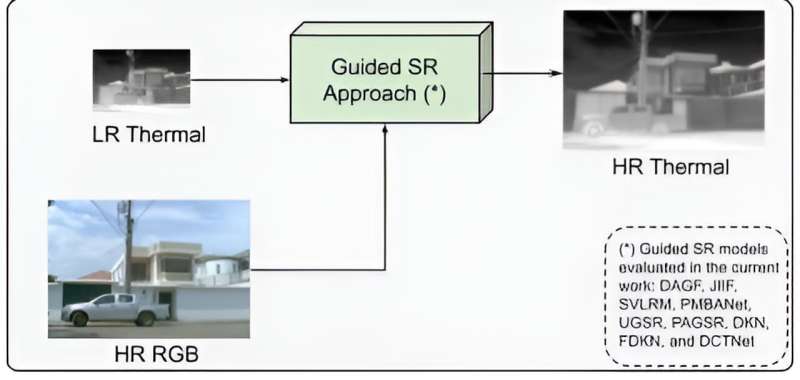
Researchers if CIDIS at ESPOL Polytechnic University have developed a new method to enhance thermal image super-resolution by employing synthetic imagery. This novel approach utilizes high-resolution images from the visible spectrum to guide the super-resolution of low-resolution thermal images, significantly improving the detail and utility of thermal imaging across various applications. The work is published in the journal Neurocomputing.
When visualizing thermal images, one typically imagines the blurry, less-detailed outputs common with standard thermal imaging cameras. However, with guided super-resolution techniques, these images can now be enhanced to provide much clearer, more useful visual data. The latest breakthrough in this technology introduces synthetic thermal images generated from high-resolution visible images to provide a more accurate guiding framework for super-resolution processes.
Unlike conventional methods, where the guiding image might not perfectly align with the thermal characteristics, synthetic thermal images mimic the desired thermal traits more closely. This alignment greatly improves the quality and accuracy of the super-resolution output, making the process more effective for practical applications.
The process starts by generating synthetic thermal images from high-resolution visible spectrum images using advanced computational models. These synthetic images are then used as reference guides to enhance the resolution of thermal images through a super-resolution process. This method allows for a more precise enhancement, tailoring the thermal imaging to reflect more accurate and detailed thermal properties.

This enhanced super-resolution technique, using synthetic thermal imaging, is particularly effective in a wide spectrum of environments and sectors where high-quality thermal images are crucial. The benefits of better thermal imaging resolution extend to sectors such as security surveillance, environmental monitoring, and health care.
In security surveillance, the improved clarity of thermal imaging leads to better identification and assessment of potential threats, particularly in low-light or obstructed environments. Environmental monitoring benefits from this technology through more detailed and accurate thermal imaging, which is essential for tracking wildlife movements or detecting early signs of wildfires, thus contributing to timely and effective responses.
In the health care sector, the improved resolution and reliability of thermal imaging can significantly improve diagnostic processes, providing clearer images that aid in the accurate diagnosis of various conditions.
The use of thermal-like images for guiding thermal image super-resolution represents a significant advancement due to its potential to bridge the gap between visible and thermal imaging domains effectively. By utilizing synthetic images that accurately replicate thermal characteristics, the super-resolution process becomes more precise and reliable, leading to higher-quality thermal images.
This approach not only enhances the functionality of thermal cameras but also reduces the cost and complexity associated with obtaining high-quality thermal images.
More information: Patricia L. Suárez et al, Enhancement of guided thermal image super-resolution approaches, Neurocomputing (2023). DOI: 10.1016/j.neucom.2023.127197
Provided by Escuela Superior Politecnica del Litoral
Citation: Enhancement of guided thermal image super-resolution approaches (2024, May 31) retrieved 31 May 2024 from https://techxplore.com/news/2024-05-thermal-image-super-resolution-approaches.html
This document is subject to copyright. Apart from any fair dealing for the purpose of private study or research, no part may be reproduced without the written permission. The content is provided for information purposes only.
